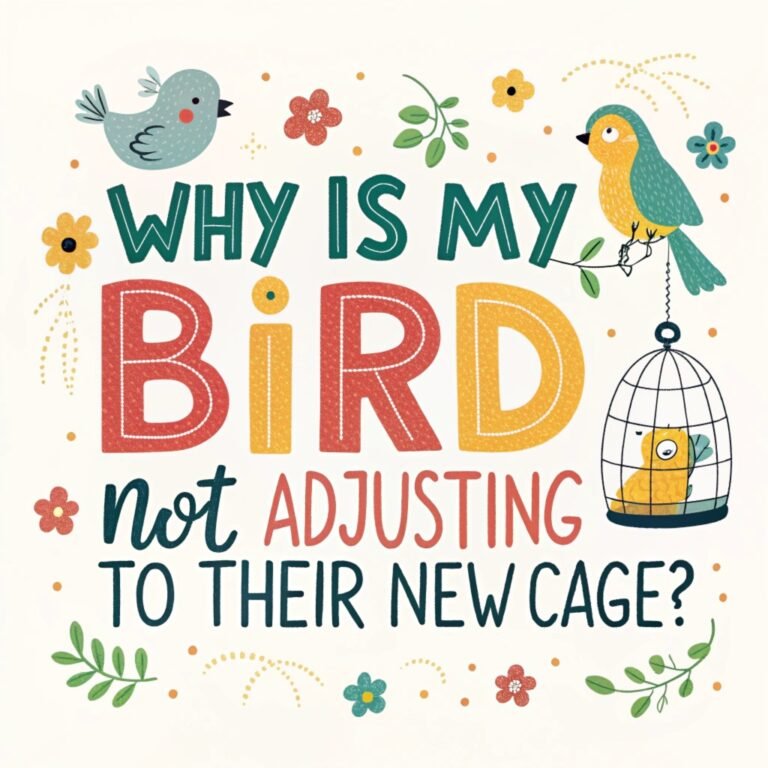How Far Should The Cage Be From Windows? Optimal Bird Cage Placement
When it comes to providing a safe and comfortable home for your feathered friend, the placement of their cage is crucial.
One of the most common questions bird owners face is how far the cage should be from windows.
This decision can significantly impact your bird’s physical and emotional well-being.

Key Takeaways
- Optimal Distance: Keep the cage at least 3-4 feet away from windows to prevent drafts and temperature fluctuations.
- Natural Light Benefits: While direct sunlight can be harmful, filtered natural light is beneficial for your bird’s health and mood.
- Safety Considerations: Avoid placing the cage directly in front of windows to prevent stress from outside stimuli and potential escape risks.
- Temperature Control: Maintain a consistent temperature by keeping the cage away from windows, heating vents, and air conditioning units.
- Visibility and Security: Position the cage so that at least one side is against a wall to provide a sense of security for your bird.
- Room Choice: Select a room with moderate activity levels to balance social interaction and quiet time for your bird.
- Elevated Placement: Set the cage at eye level or slightly higher to make your bird feel safe and comfortable.
- Avoid Kitchens: Never place the cage in or near the kitchen due to potential exposure to harmful fumes from cooking and cleaning products.
- Nighttime Considerations: Ensure the cage can be covered or moved to a quiet area for uninterrupted sleep.
- Adaptability: Be prepared to adjust cage placement based on your bird’s behavior and preferences.
- Regular Monitoring: Observe your bird’s reactions to its environment and make changes as needed to ensure its well-being.
The Importance of Proper Cage Placement
Proper cage placement is crucial for your bird’s overall well-being. The location of the cage affects not only your bird’s physical health but also its mental and emotional state.
A well-placed cage can provide a sense of security, stimulation, and comfort for your feathered friend.
On the other hand, poor placement can lead to stress, anxiety, and even health issues. When considering cage placement, it’s essential to think about factors such as natural light exposure, temperature control, and social interaction.
The right balance of these elements can create an environment that promotes your bird’s natural behaviors and encourages a healthy, happy life.
Remember that birds are highly sensitive to their surroundings, and even small changes in their environment can have a significant impact on their well-being.
Understanding the Impact of Windows on Birds

Windows play a significant role in a bird’s environment, both positively and negatively. On the positive side, windows provide natural light, which is essential for a bird’s circadian rhythm and overall health.
Natural light helps regulate your bird’s sleep-wake cycle and promotes the production of vitamin D3, which is crucial for calcium absorption and bone health.
Additionally, windows offer visual stimulation, allowing your bird to observe the outside world, including other birds, trees, and changing weather patterns.
This can be mentally stimulating and help prevent boredom. However, windows can also pose potential risks. Direct sunlight through a window can cause overheating, especially in small cages or for birds with limited mobility.
Ideal Distance Between Cage and Windows
The ideal distance between your bird’s cage and windows is typically 3 to 4 feet. This distance provides a balance between the benefits of natural light and the potential risks associated with window placement.
At this distance, your bird can still enjoy filtered natural light and some view of the outdoors without being directly exposed to drafts, temperature fluctuations, or excessive stimulation from outside activity.
It’s important to note that this distance may need to be adjusted based on factors such as the size of your room, the type of windows, and your bird’s specific needs.
For larger birds or in rooms with floor-to-ceiling windows, you might need to increase this distance to 5 or 6 feet. The key is to observe your bird’s behavior and comfort level.
Benefits of Natural Light for Birds

Natural light plays a vital role in maintaining your bird’s health and well-being. Exposure to natural light helps regulate your bird’s circadian rhythm, which is crucial for maintaining normal sleep patterns and hormone production.
Sunlight also stimulates the production of vitamin D3 in your bird’s skin, which is essential for calcium absorption and bone health.
This is particularly important for birds prone to calcium deficiencies or egg-laying females. Natural light can also enhance your bird’s mood and behavior.
Many bird owners report that their feathered friends are more active, vocal, and engaged when exposed to natural light.
It can stimulate natural behaviors such as preening, foraging, and playing. Additionally, the changing intensity and color of natural light throughout the day provides visual stimulation and helps prevent boredom.
Risks of Placing Cages Too Close to Windows
Placing bird cages too close to windows can pose several potential risks to your feathered friend’s health and well-being. One of the primary concerns is temperature fluctuation.
Windows can create drafts and allow rapid temperature changes, which can be detrimental to a bird’s delicate respiratory system.
Birds are particularly sensitive to cold drafts, which can lead to respiratory infections or exacerbate existing health issues.
Another risk is overexposure to direct sunlight. While natural light is beneficial, too much direct sunlight can cause overheating, especially in small cages or for birds with limited mobility.
This can lead to heat stress or even heat stroke in severe cases. Windows also present a visual challenge for birds.
Sudden movements outside, such as passing cars or predators, can startle your bird, causing stress and anxiety.
In some cases, this constant stimulation can lead to chronic stress, which can weaken the bird’s immune system and make it more susceptible to illness.
Temperature Considerations for Bird Cages
Maintaining an appropriate temperature is crucial for your bird’s health and comfort. Birds are sensitive to temperature changes, and their cages should be placed in an area with a stable, comfortable temperature.
The ideal temperature range for most pet birds is between 65°F and 80°F (18°C to 27°C). However, this can vary depending on the species, so it’s essential to research the specific needs of your bird.
When considering cage placement in relation to windows, be aware that areas near windows can experience significant temperature fluctuations.
In summer, sunlight streaming through a window can create a greenhouse effect, rapidly raising the temperature in that area.
Conversely, in winter, windows can be a source of cold drafts. To mitigate these issues, avoid placing the cage directly in front of or too close to windows.
If the cage must be near a window, consider using thermal curtains or blinds to help regulate temperature.
Creating a Sense of Security for Your Bird
Birds, like many animals, have an innate need for security in their environment. In the wild, birds often seek out protected areas for nesting and resting, and this instinct carries over to captive birds as well.
When placing your bird’s cage, it’s important to consider how you can create a sense of security for your feathered friend.
One effective way to do this is by positioning the cage so that at least one side is against a wall. This mimics the natural protection a bird might find in the wild and can help your pet feel safe and secure.
Avoid placing the cage in the center of a room where your bird might feel exposed from all sides.
Additionally, consider providing hiding spots within the cage itself. These can be in the form of bird huts, hanging toys with fabric strips, or even strategically placed perches that allow your bird to retreat to a more secluded area when it feels the need.
Balancing Natural Light and Privacy
Finding the right balance between natural light and privacy is essential for your bird’s well-being. While natural light is beneficial, too much exposure can be stressful, especially if your bird feels constantly on display.
To achieve this balance, consider using sheer curtains or blinds that allow filtered light to enter while providing some visual barrier.
This can help your bird feel more secure while still benefiting from natural light. Another option is to create a partially enclosed area within the cage using bird-safe plants or hanging toys.
This allows your bird to retreat to a more private space when it feels the need, while still having access to light and visibility.
It’s also important to consider the time of day when positioning the cage. Morning light can be invigorating for birds, so you might want to orient the cage to catch early sunlight.
Choosing the Right Room for Your Bird’s Cage
Selecting the appropriate room for your bird’s cage is a crucial decision that can significantly impact your feathered friend’s quality of life. The ideal room should strike a balance between social interaction and quiet time.
Living rooms or family rooms are often good choices as they provide opportunities for your bird to be part of family activities.
However, ensure the room isn’t too hectic or noisy, as this can cause stress. Avoid placing the cage in the kitchen due to potential exposure to harmful fumes from cooking and cleaning products.
Bedrooms can be suitable, especially if you spend a lot of time there, but be mindful of your bird’s need for uninterrupted sleep.
The chosen room should have good ventilation but be free from drafts. Consider the room’s temperature stability throughout the day and seasons.
Natural light is important, but ensure there’s a way to control it, such as with adjustable blinds or curtains. The room should also be easily accessible for daily care and interaction.
The Role of Elevation in Cage Placement
The elevation at which you place your bird’s cage plays a significant role in your pet’s sense of security and overall well-being. In the wild, birds often perch in high places to survey their surroundings and stay safe from ground predators.
This instinct remains strong in captive birds, which is why many feel more comfortable when their cages are elevated. Ideally, the bottom of the cage should be at or slightly above your eye level.
This height allows your bird to feel secure while still being able to interact with you comfortably.
Elevated cages also help protect your bird from drafts that often occur at floor level and keep them away from potential hazards like other pets or accidental kicks. However, the cage shouldn’t be placed so high that it’s difficult for you to reach for daily care and interaction.
Avoiding Common Cage Placement Mistakes
When setting up your bird’s cage, it’s crucial to avoid common placement mistakes that could negatively impact your feathered friend’s health and happiness.
One frequent error is placing the cage in direct sunlight or too close to windows, which can lead to overheating and stress.
Another mistake is positioning the cage in high-traffic areas or near doors that open and close frequently, as this can startle your bird and cause anxiety.
Avoid placing the cage near air vents, fans, or air conditioners, as the direct airflow can be harmful to your bird’s respiratory system.
Many bird owners mistakenly put cages in kitchens, unaware of the dangers posed by cooking fumes and cleaning products.
It’s also a mistake to place the cage too low, such as on the floor, as this can make your bird feel vulnerable. Conversely, placing the cage too high, where it’s difficult for you to reach, can lead to neglect in daily care and interaction.
Some owners make the error of putting the cage in a room that’s rarely used, leading to isolation and boredom for the bird. Lastly, failing to secure the cage properly, especially for larger birds, can be a dangerous oversight.
Adapting Cage Placement for Different Bird Species
Different bird species have unique needs when it comes to cage placement, and it’s essential to adapt your approach accordingly.
For example, parrots, known for their intelligence and need for stimulation, often thrive in busier areas of the home where they can observe and interact with family activities.
However, they also need a quiet space to retreat to when overstimulated. Finches and canaries, being more active and flighty, may prefer cages placed higher up and away from sudden movements that could startle them.
Cockatiels, which are prone to night frights, benefit from having their cages partially covered at night and placed in a quiet area.
Larger birds like macaws or cockatoos need more space and may require specially reinforced areas to support their heavier cages.
Some species, like budgies, enjoy watching outdoor activities and may appreciate a cage placed near (but not directly in front of) a window.
African Grey parrots, known for their sensitivity, often prefer quieter environments with consistent routines.
Always research your specific bird species to understand their particular needs. Consider factors such as their natural habitat, social needs, noise tolerance, and temperature preferences when deciding on cage placement.
Monitoring Your Bird’s Behavior After Cage Relocation
After relocating your bird’s cage, it’s crucial to closely monitor your feathered friend’s behavior for signs of stress or discomfort. Birds are creatures of habit and can be sensitive to changes in their environment.
Pay attention to your bird’s activity level, appetite, and vocalizations. A happy, well-adjusted bird should maintain its normal eating habits, engage in regular preening, and display its usual level of activity and vocalization.
Signs of stress may include decreased appetite, lethargy, excessive screaming, feather plucking, or aggressive behavior.
Some birds may show signs of stress by becoming unusually quiet or hiding more than usual.
If you notice any of these behaviors, consider adjusting the cage placement or providing additional comfort measures.
It’s normal for birds to take some time to adjust to a new location, typically a few days to a week.
During this adjustment period, maintain your bird’s regular routine as much as possible, including feeding times and social interactions.
Provide familiar toys and perches to help your bird feel secure in its new spot. If stress behaviors persist beyond a week or if you notice any signs of illness, consult with an avian veterinarian.
Creating a Stimulating Environment Around the Cage
While the placement of the cage is important, creating a stimulating environment around it is equally crucial for your bird’s mental and physical well-being.
Start by ensuring the area around the cage is safe for your bird during out-of-cage time. Remove any potential hazards such as toxic plants, electrical cords, or small objects that could be swallowed.
FAQs
Is it okay to place my bird’s cage next to a window?
It’s best not to place cages directly next to windows due to risks like drafts, temperature changes, and overstimulation.
How much natural light does my bird need?
Birds benefit from 10–12 hours of natural light daily but should avoid prolonged exposure to direct sunlight.
What should I do if my bird seems stressed near a window?
Move the cage further away or use curtains/blinds to limit visual stimulation while maintaining access to filtered light.
Can I keep my bird’s cage outside during the day?
Outdoor time can be beneficial but should always be supervised with proper protection against predators and weather conditions.By following these guidelines on window proximity and overall placement strategies, you’ll create an ideal living space that prioritizes both safety and happiness for your feathered companion!

Hello, I’m Amelia White, the founder of birdsfanatic.com. As a lifelong bird enthusiast and spiritual seeker, I’ve always been fascinated by the mystical connections between birds and the human experience. On this site, I share my knowledge and insights into the symbolic meanings and spiritual significance of various bird species, exploring their roles in mythology, folklore, and cultural traditions. Join me on this journey into the world of birds, where we’ll discover the hidden wisdom and guidance that these magnificent creatures have to offer.







